Zhuangzhuang Cui
Near-Field Spatial non-Stationary Channel Estimation: Visibility-Region-HMM-Aided Polar-Domain Simultaneous OMP
Aug 06, 2025Abstract:This work focuses on channel estimation in extremely large aperture array (ELAA) systems, where near-field propagation and spatial non-stationarity introduce complexities that hinder the effectiveness of traditional estimation techniques. A physics-based hybrid channel model is developed, incorporating non-binary visibility region (VR) masks to simulate diffraction-induced power variations across the antenna array. To address the estimation challenges posed by these channel conditions, a novel algorithm is proposed: Visibility-Region-HMM-Aided Polar-Domain Simultaneous Orthogonal Matching Pursuit (VR-HMM-P-SOMP). The method extends a greedy sparse recovery framework by integrating VR estimation through a hidden Markov model (HMM), using a novel emission formulation and Viterbi decoding. This allows the algorithm to adaptively mask steering vectors and account for spatial non-stationarity at the antenna level. Simulation results demonstrate that the proposed method enhances estimation accuracy compared to existing techniques, particularly in low-SNR and sparse scenarios, while maintaining a low computational complexity. The algorithm presents robustness across a range of design parameters and channel conditions, offering a practical solution for ELAA systems.
CASH: Context-Aware Smart Handover for Reliable UAV Connectivity on Aerial Corridors
Aug 05, 2025Abstract:Urban Air Mobility (UAM) envisions aerial corridors for Unmanned Aerial Vehicles (UAVs) to reduce ground traffic congestion by supporting 3D mobility, such as air taxis. A key challenge in these high-mobility aerial corridors is ensuring reliable connectivity, where frequent handovers can degrade network performance. To resolve this, we present a Context-Aware Smart Handover (CASH) protocol that uses a forward-looking scoring mechanism based on UAV trajectory to make proactive handover decisions. We evaluate the performance of the proposed CASH against existing handover protocols in a custom-built simulator. Results show that CASH reduces handover frequency by up to 78% while maintaining low outage probability. We then investigate the impact of base station density and safety margin on handover performance, where their optimal setups are empirically obtained to ensure reliable UAM communication.
BS-Breath: Respiration Sensing with Cell-free Massive MIMO
Feb 17, 2025Abstract:This paper demonstrates the feasibility of respiration pattern estimation utilizing a communication-centric cellfree massive MIMO OFDM Base Station (BS). The sensing target is typically positioned near the User Equipment (UE), which transmits uplink pilots to the BS. Our results demonstrate the potential of massive MIMO systems for accurate and reliable vital sign estimation. Initially, we adopt a single antenna sensing solution that combines multiple subcarriers and a breathing projection to align the 2D complex breathing pattern to a single displacement dimension. Then, Weighted Antenna Combining (WAC) aggregates the 1D breathing signals from multiple antennas. The results demonstrate that the combination of space-frequency resources specifically in terms of subcarriers and antennas yields higher accuracy than using only a single antenna or subcarrier. Our results significantly improved respiration estimation accuracy by using multiple subcarriers and antennas. With WAC, we achieved an average correlation of 0.8 with ground truth data, compared to 0.6 for single antenna or subcarrier methods, a 0.2 correlation increase. Moreover, the system produced perfect breathing rate estimates. These findings suggest that the limited bandwidth (18 MHz in the testbed) can be effectively compensated by utilizing spatial resources, such as distributed antennas.
Measurement-Based Modeling and Analysis of UAV Air-Ground Channels at 1 and 4 GHz
Jan 28, 2025Abstract:In the design of unmanned aerial vehicle (UAV) wireless communications, a better understanding of propagation characteristics and an accurate channel model are required. Measurements and comprehensive analysis for the UAV-based air-ground (AG) propagation channel in the vertical dimension are presented in this letter. Based on the measurement data at 1 and 4 GHz, the large-scale and small-scale channel parameters are extracted in the line-of-sight (LOS) and nonLOS case, respectively. The altitude-dependent path loss model is proposed herein. Furthermore, shadow fading and fast fading are statistically analyzed for comprehensively describing the fading behavior. Our results will be useful in the modeling of AG channels and the performance analysis for UAV-enabled wireless communication systems.
On the Ground and in the Sky: A Tutorial on Radio Localization in Ground-Air-Space Networks
Dec 09, 2023Abstract:The inherent limitations in scaling up ground infrastructure for future wireless networks, combined with decreasing operational costs of aerial and space networks, are driving considerable research interest in multisegment ground-air-space (GAS) networks. In GAS networks, where ground and aerial users share network resources, ubiquitous and accurate user localization becomes indispensable, not only as an end-user service but also as an enabler for location-aware communications. This breaks the convention of having localization as a byproduct in networks primarily designed for communications. To address these imperative localization needs, the design and utilization of ground, aerial, and space anchors require thorough investigation. In this tutorial, we provide an in-depth systemic analysis of the radio localization problem in GAS networks, considering ground and aerial users as targets to be localized. Starting from a survey of the most relevant works, we then define the key characteristics of anchors and targets in GAS networks. Subsequently, we detail localization fundamentals in GAS networks, considering 3D positions and orientations. Afterward, we thoroughly analyze radio localization systems in GAS networks, detailing the system model, design aspects, and considerations for each of the three GAS anchors. Preliminary results are presented to provide a quantifiable perspective on key design aspects in GAS-based localization scenarios. We then identify the vital roles 6G enablers are expected to play in radio localization in GAS networks.
3D Non-Stationary Channel Measurement and Analysis for MaMIMO-UAV Communications
Oct 10, 2023Abstract:Unmanned aerial vehicles (UAVs) have gained popularity in the communications research community because of their versatility in placement and potential to extend the functions of communication networks. However, there remains still a gap in existing works regarding detailed and measurement-verified air-to-ground (A2G) Massive Multi-Input Multi-Output (MaMIMO) channel characteristics which play an important role in realistic deployment. In this paper, we first design a UAV MaMIMO communication platform for channel acquisition. We then use the testbed to measure uplink Channel State Information (CSI) between a rotary-wing drone and a 64-element MaMIMO base station (BS). For characterization, we focus on multidimensional channel stationarity which is a fundamental metric in communication systems. Afterward, we present measurement results and analyze the channel statistics based on power delay profiles (PDPs) considering space, time, and frequency domains. We propose the stationary angle (SA) as a supplementary metric of stationary distance (SD) in the time domain. We analyze the coherence bandwidth and RMS delay spread for frequency stationarity. Finally, spatial correlations between elements are analyzed to indicate the spatial stationarity of the array. The space-time-frequency channel stationary characterization will benefit the physical layer design of MaMIMO-UAV communications.
Sensing with OFDM Waveform at mmWave Band based on Micro-Doppler Analysis
Mar 29, 2023Abstract:Joint communication and sensing (JCAS) technology has been regarded as one of the innovations in the 6G network. With the channel modeling proposed by the 3rd Generation Partnership Project (3GPP) TR 38.901, this paper investigates the sensing capability using the millimeter-wave (mmWave) band with an orthogonal frequency division multiplexing (OFDM) waveform. Based on micro-Doppler (MD) analysis, we present two case studies, i.e., fan speed detection and human activity recognition, to demonstrate the target modeling with micro-motions, backscattering signal construction, and MD signature extraction using an OFDM waveform at 28 GHz. Simulated signatures demonstrate distinct fan rotation or human motion, and waveform parameters that affect the MD signature extraction are analyzed. Simulation results draw the validity of the proposed modeling and simulation methods, which also aim to facilitate the generation of data sets for various JCAS applications.
Cluster-based Characterization and Modeling for UAV Air-to-Ground Time-Varying Channels
Aug 26, 2021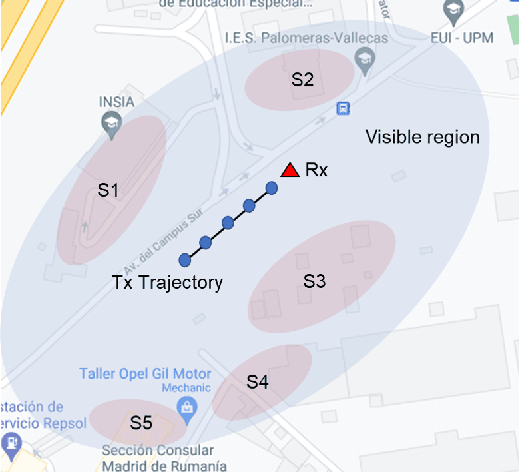
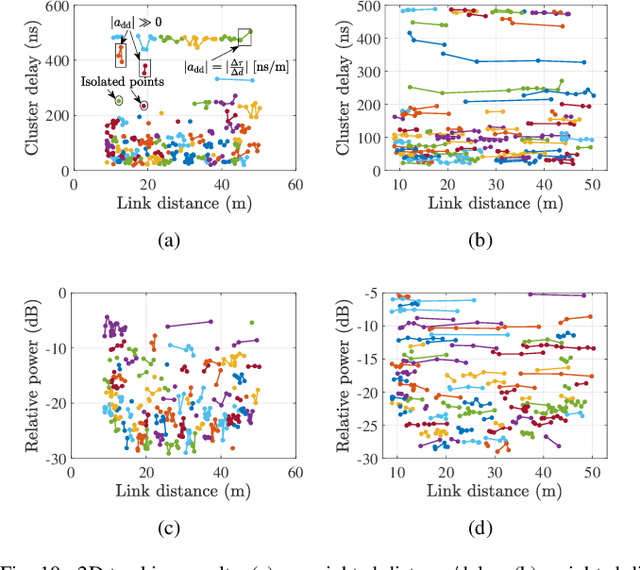
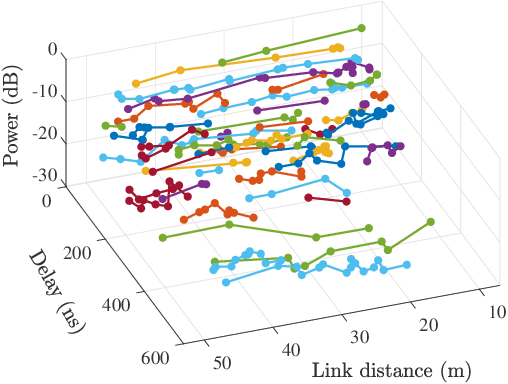
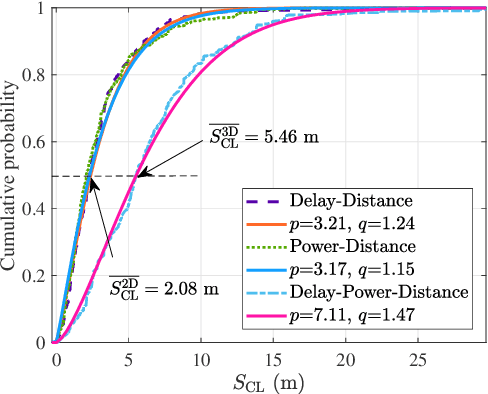
Abstract:With the deep integration between the unmanned aerial vehicle (UAV) and wireless communication, UAV-based air-to-ground (AG) propagation channels need more detailed descriptions and accurate models. In this paper, we aim to perform cluster-based characterization and modeling for AG channels. To our best knowledge, this is the first study that concentrates on the clustering and tracking of multipath components (MPCs) for time-varying AG channels. Based on measurement data at 6.5 GHz with 500 MHz of bandwidth, we first estimate potential MPCs utilizing the space-alternating generalized expectation-maximization (SAGE) algorithm. Then, we cluster the extracted MPCs considering their static and dynamic characteristics by employing K-Power-Means (KPM) algorithm under multipath component distance (MCD) measure. For characterizing time-variant clusters, we exploit a clustering-based tracking (CBT) method, which efficiently quantifies the survival lengths of clusters. Ultimately, we establish a cluster-based channel model, and validations illustrate the accuracy of the proposed model. This work not only promotes a better understanding of AG propagation channels but also provides a general cluster-based AG channel model with certain extensibility.
Coverage Analysis of Cellular-Connected UAV Communications with 3GPP Antenna and Channel Models
May 28, 2021


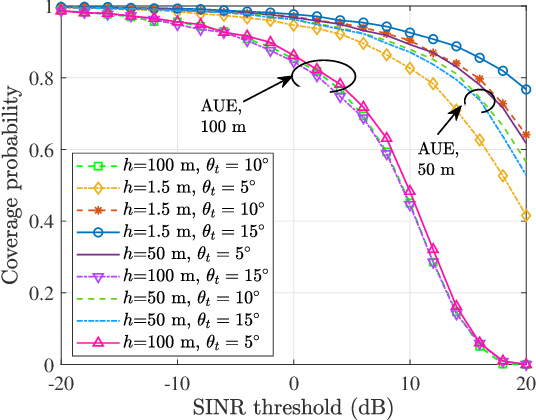
Abstract:For reliable and efficient communications of aerial platforms, such as unmanned aerial vehicles (UAVs), the cellular network is envisioned to provide connectivity for the aerial and ground user equipment (GUE) simultaneously, which brings challenges to the existing pattern of the base station (BS) tailored for ground-level services. Thus, we focus on the coverage probability analysis to investigate the coexistence of aerial and terrestrial users, by employing realistic antenna and channel models reported in the 3rd Generation Partnership Project (3GPP). The homogeneous Poisson point process (PPP) is used to describe the BS distribution, and the BS antenna is adjustable in the down-tilted angle and the number of the antenna array. Meantime, omnidirectional antennas are used for cellular users. We first derive the approximation of coverage probability and then conduct numerous simulations to evaluate the impacts of antenna numbers, down-tilted angles, carrier frequencies, and user heights. One of the essential findings indicates that the coverage probabilities of high-altitude users become less sensitive to the down-tilted angle. Moreover, we found that the aerial user equipment (AUE) in a certain range of heights can achieve the same or better coverage probability than that of GUE, which provides an insight into the effective deployment of cellular-connected aerial communications.
 Add to Chrome
Add to Chrome Add to Firefox
Add to Firefox Add to Edge
Add to Edge